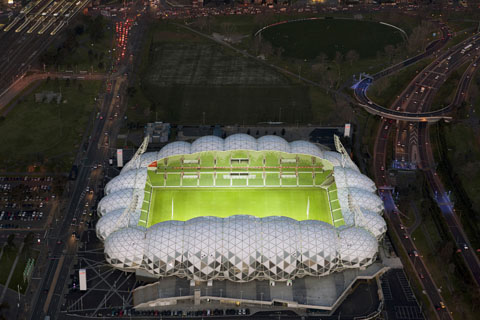Are you working in the area of lightweight structures - tensioned fabric or membrane structures, cablenets, high tech glazing or other forms of innovative structures?
Possibly you should consider becoming a member of LSAA?
Most LSAA Members have been involved with either membrane structures (design, fabrication, erection, or supply of materials and fittings) for a considerable period of time. Others are involved with innovative new forms of architecture such as high tech glazing, cablenets, spaceframes, laminated timber, curved surfaces and bridges.
Current financial members of LSAA are entitled to use the LSAA logo on their correspondence and website.
We would encourage that members websites displaying the logo also provide a link back to the LSAA website.
Note that the current version is shown below and has been adopted since the lead up to the LSAA 2016 Conference.

LSAA Mission Statement:
"To lead, promote and develop excellence and innovation in lightweight structures by inspiring research and disseminating expert knowledge to expand the industry and opportunities for our members".
The Lightweight Structures Association is a Not for Profit, autonomous, inter-disciplinary group of interested parties involved in the field of lightweight structures. Operating primarily in Australia and New Zealand our basic aim is to promote the proper application of lightweight structures, their design, fabrication, construction and materials and to encourage the development of these and other aspects essential to lightweight structures.
Download a brochure about the LSAA, its activities and types of structures we deal with.
Download a Member Application Form
The Lightweight Structures Association is a Not for Profit, autonomous, inter-disciplinary group of interested parties involved in the field of lightweight structures. Operating primarily in Australia and New Zealand our basic aim is to promote the proper application of lightweight structures, their design, fabrication, construction and materials and to encourage the development of these and other aspects essential to lightweight structures.
Back to LSAA Homepage
The objectives of the Association are:
- To establish itself as a reference body on lightweight structures;
- To collect and disseminate information in the field of its members, encouraging the exchange of information between members and those interested, through publications and the organisation of meetings, seminars and conferences;
- To promote the proper application of lightweight structures;
LSAA COMMITTEE AND CONTACT DETAILS
The main contact for LSAA is:
Email (best):
Phone: Australia Mob 0428 414 093
Postal: P.O. Box 4047, Oatley, NSW, Australia 2223
Typical lightweight structures include cable-, membrane-, shell-, and folded structures as well as space grids, braced vaults and domes, arched-, stayed-and trussed systems. Membrane materials are commonly PVC-coated polyester fabrics as well as PTFE coated glass. Lightweight structures are widely employed in architecture, engineering and building construction and find application in long span roofs for stadiums and exhibition structures; covered shopping malls; entrance structures; signature structures and sculptures as well as shade and environmental protection canopies.
The following links are provided for your use (last update May 1 2025):
Engineers Australia (EA)
Royal Australian Institute of Architects (RAIA)
Specialized Textiles Association (formerly ACASPA) (STA)
Australian Council of Fashion and Textiles ((AUFC))
Advanced Textiles Association (formerly IFAI) (ATO)
International Association for Shell and Spatial Structures ((IASS)
Fabric Structures Association (FSA)
Australian Steel Institute (ASI)
Technical work being undertaken by the LSAA is currently focused on the PFAS environmental debate.
Recent attention has been on Fire Issues following on fires being spread up tall buildings because of inappropriate use of combustible cladding material.
Disclaimer and Privacy
Material on this website is provided for general interest/information purposes. Reliance upon information contained in this website shall be at the user’s own risk.
We accept no responsibility or liability for any damage or technical malfunctions, resulting from your use of this website, or for any viruses or other problems that may infect your computer or related equipment.
LSAA Members Code of Ethics
- The responsibility of members for the welfare, health and safety of the community shall at all times come before their responsibility to the Industry and their Profession, to sectional or private interests, or to other members.
- Members shall act so as to uphold and enhance the honour, integrity and dignity of the Industry and their Profession.
- Members shall perform work only in their areas of competence.
LSAA Statement on Privacy and Personal Information
1. About this Privacy Statement
The Lightweight Structures Association of Australiasia Inc. (LSAA) is bound by the National Privacy principles in the Privacy Act 1988 (Commonwealth) in relation to the handling of personal information. This statement sets out its commitment to privacy.
2. Personal information collected
LSAA recognises the importance of protecting the privacy of personal information collected for members and others seeking technical assistance from LSAA.
Page 1 of 2









